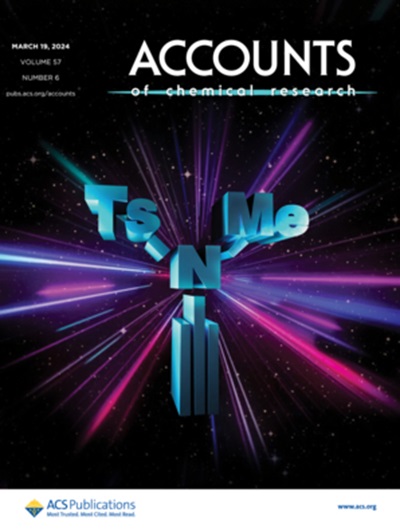Single Nanowire Sensors for Intracellular Electrochemical Measurement.
IF 17.7
1区 化学
Q1 CHEMISTRY, MULTIDISCIPLINARY
引用次数: 0
Abstract
ConspectusCells serve as the fundamental unit underlying the structure and function of living organisms, demonstrating rapid responses and dynamic changes among various biochemical components within the cytoplasm and organelles. Any abnormal alterations in these components can lead to diseases. Thus, single-cell analysis is crucial for exploring life activities and understanding the causes of disease emergence and progression. Nanoelectrochemical sensors exhibit remarkable characteristics such as high spatiotemporal resolution, robust quantitative capabilities, and the ability to enable real-time monitoring of dynamic activities in specific cellular regions. The rapid advancement of nanotechnology along with the increasing demand for biological detection has created a need for more stringent technical standards for nanoelectrochemical sensors intended for single-cell analysis. First, significant breakthroughs are required in precision manufacturing processes for nanoscale tips to ensure that the sensors demonstrate ultralow invasiveness when penetrating cells. Additionally, the preparation processes for electrode materials must be optimized to facilitate scalable production while ensuring high stability and reproducibility. Furthermore, there is an urgent need to develop precise and controllable surface modification techniques that will yield highly specific and sensitive functionalized detection interfaces. The development of electrochemical nanosensors that satisfy these criteria will greatly enhance the ability to conduct highly sensitive and selective quantitative analyses of low-concentration components within individual cells.This Account presents a comprehensive overview of the development of advanced core-shell nanowire sensors specifically designed for single-cell-level detection. It encompasses flexible construction strategies and intracellular detection methods as well as their application in addressing significant physiological challenges. Typically, the nanowire sensor is made of nanowires with a core-shell structure. The core is a rigid nanowire with various diameters as the electrode skeleton, whereas the shell is a conductive and functionalized material as a sensing interface. Notably, conductive nanoshell layers with high catalytic properties can be synthesized in bulk and well-controlled on nanowire substrates. These flexible synthesis strategies allow the range of single nanowires to be extended beyond the limitations of the current electrode materials. Using nanofabrication techniques, these functional nanowires can be assembled into individual nanowire electrodes for highly sensitive monitoring of a single species or into multichannel nanowire sensors to analyze multiple targets simultaneously.Nanowire sensors are used to quantitatively monitor key species in cellular life processes by combining various detection modes (e.g., amperometry, potentiometry, and coulometry). Therefore, information about the concentration and kinetics of metabolite substances (e.g., NADH and ATP), redox species (e.g., ROS/RNS and GSH), and neurotransmitters (e.g., dopamine and glutamate) could be accurately obtained at the single and subcellular level. A deeper understanding of the mechanisms driving regular physiological changes and the pathogenesis within individual cells has emerged. In particular, significant discoveries have been made regarding the regulatory mechanisms of pharmacodynamics of anticancer drugs, redox homeostasis in macrophages, and the partial release patterns of neurotransmitters.用于细胞内电化学测量的单纳米线传感器。
细胞是生物体结构和功能的基本单位,在细胞质和细胞器内表现出各种生化成分的快速反应和动态变化。这些成分的任何异常改变都可能导致疾病。因此,单细胞分析对于探索生命活动和了解疾病发生和发展的原因至关重要。纳米电化学传感器具有显著的特点,如高时空分辨率,强大的定量能力,以及能够实时监测特定细胞区域的动态活动。随着纳米技术的快速发展以及对生物检测需求的不断增长,需要对用于单细胞分析的纳米电化学传感器制定更严格的技术标准。首先,需要在纳米级尖端的精密制造工艺上取得重大突破,以确保传感器在穿透细胞时表现出超低的侵入性。此外,必须优化电极材料的制备工艺,以促进可扩展生产,同时确保高稳定性和可重复性。此外,迫切需要开发精确和可控的表面修饰技术,以产生高度特异性和敏感性的功能化检测界面。满足这些标准的电化学纳米传感器的发展将大大提高对单个细胞内低浓度成分进行高灵敏度和选择性定量分析的能力。本帐户提出了先进的核-壳纳米线传感器的发展,专门为单细胞水平检测的全面概述。它包括灵活的构建策略和细胞内检测方法,以及它们在解决重大生理挑战中的应用。通常,纳米线传感器是由具有核壳结构的纳米线制成的。芯是一种具有不同直径的刚性纳米线作为电极骨架,而壳是一种导电和功能化材料作为传感接口。值得注意的是,具有高催化性能的导电纳米壳层可以在纳米线衬底上批量合成并得到很好的控制。这些灵活的合成策略允许单纳米线的范围扩展到超越当前电极材料的限制。利用纳米制造技术,这些功能纳米线可以组装成单独的纳米线电极,用于对单一物种的高灵敏度监测,或者组装成多通道纳米线传感器,以同时分析多个目标。纳米线传感器通过结合各种检测模式(如安培法、电位法和库仑法),用于定量监测细胞生命过程中的关键物种。因此,关于代谢物(如NADH和ATP)、氧化还原物质(如ROS/RNS和GSH)和神经递质(如多巴胺和谷氨酸)的浓度和动力学信息可以在单个和亚细胞水平上准确获得。对驱动正常生理变化的机制和单个细胞内的发病机制有了更深入的了解。特别是在抗癌药物的药效学、巨噬细胞的氧化还原稳态和神经递质部分释放模式的调节机制方面取得了重大发现。
本文章由计算机程序翻译,如有差异,请以英文原文为准。
求助全文
约1分钟内获得全文
求助全文
来源期刊

Accounts of Chemical Research
化学-化学综合
CiteScore
31.40
自引率
1.10%
发文量
312
审稿时长
2 months
期刊介绍:
Accounts of Chemical Research presents short, concise and critical articles offering easy-to-read overviews of basic research and applications in all areas of chemistry and biochemistry. These short reviews focus on research from the author’s own laboratory and are designed to teach the reader about a research project. In addition, Accounts of Chemical Research publishes commentaries that give an informed opinion on a current research problem. Special Issues online are devoted to a single topic of unusual activity and significance.
Accounts of Chemical Research replaces the traditional article abstract with an article "Conspectus." These entries synopsize the research affording the reader a closer look at the content and significance of an article. Through this provision of a more detailed description of the article contents, the Conspectus enhances the article's discoverability by search engines and the exposure for the research.
 求助内容:
求助内容: 应助结果提醒方式:
应助结果提醒方式:


